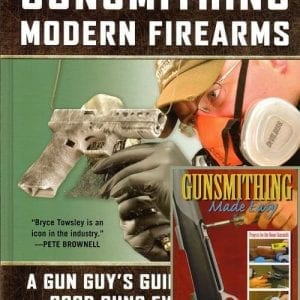The overhead light at the ATM was burned out and it was dark as I exited the car. Almost at once I noticed several attackers. I drew my 1911 and tried to see the front sight as I pointed at the closest one. There were security lights shining in my eyes, which made it harder to see the target, while the black on black sights that had worked so well at the range just disappeared. I made my best guess and did a fast double-tap.
Then I moved the gun to the next threat. The smoke from my shots hung in the still air and the security lights shining through backlit it until it appeared like a sheer curtain. I fired three times at the next threat, then twice at the third. By now the backlit smoke filling the air was hiding all the targets. I did a fast reload and turned to engage the last three threats. I was point shooting, as I had no idea where the targets were and I could not see my sights. I reloaded with my last magazine and kept shooting. When the gun was empty, I realized that several of the threats were still standing and I was out of ammo and out of time.
OK, so this was a stage at my first Smith & Wesson IDPA Indoor Championship several years ago. But, it could very well have been real life and it taught me some valuable lessons.
It was my first time shooting seriously in low light or no light situations and it was an eye opener. I have since shot several more times at this annual match as well as in other night matches, including the Crimson Trace Midnight 3-gun match. I have also made it a point to practice in low, or no light. The lessons I have learned have helped my scores improve, but more importantly they have identified problems that have caused me make some serious changes in my carry gear and training protocols.
Most serious gun guys spend time training. We practice at the range with our carry gear until our draw and first shot on target is lightning fast. We can double tap multiple targets with machine gun speed and reloads are so fast the eye can’t follow.
But we do it all in good light.
The sad truth is, the bad guy’s natural habitat is the shadows of the night and most gunfights happen in poor or complicated lighting.
The answer?
Train at night, both with and without a light. It might take some looking, but find a range where you can shoot at night, or at least indoors with the lights off. You will be amazed at the deficiencies in your carry gear that you didn’t even know you had.
 Then try to find some night competitions. I guarantee that the match directors will have some unique and challenging lighting conditions, things you never thought of. Plus the stress of competition is the closest thing to a real gunfight that most civilians can find. Force on force is the only thing better, but that takes special gear and a controlled environment. You can do it at some of the training schools, but it’s expensive.
Then try to find some night competitions. I guarantee that the match directors will have some unique and challenging lighting conditions, things you never thought of. Plus the stress of competition is the closest thing to a real gunfight that most civilians can find. Force on force is the only thing better, but that takes special gear and a controlled environment. You can do it at some of the training schools, but it’s expensive.
The key is to train with all your sighting and lighting systems and in a wide range of conditions.
You can’t use it in IDPA competition, but get a laser sight. It is perhaps the best option you can add to a carry gun. All my serious carry pistols and defensive rifles have laser sights on them. (I’ll cover lasers in depth in a future posting.)
The laser should turn on instinctively. The last thing you want to do in a threat situation is to be looking for the activation button.
Train with the sight, because it’s a different technique. But once you learn how to use it, it will amaze you. Don’t buy into the weak arguments against them that some stuck in the mud trainers have. Replace the batteries on a regular schedule and train hard and you won’t have any issues. Besides, even if the laser fails, you still have the sights.
Night Sights
Pistol sights are worthless if you can’t see them. In poor light you can’t see most sights, even fiber optics. Install a good set of night sights that glow in the dark. Make sure the front and rear have contrasting colors and or different dot size so you know which is which. Make sure you practice with them in low light so you know what to look for.
Lights
You have two options here, carry a flashlight or use a weapon mounted light. The problem with a flashlight is you must hold it in your weak hand, which screws up how you hold the gun. They can be dropped, it’s one more thing to get into play, so it takes more time and more thinking. Plus, they never seem to be pointed at the right thing. Yes, it’s all about training. You can train hard to learn all the tactical flashlight holds and learn to shoot your gun with one hand or with an awkward two hand hold. Or you can use a weapon mounted light.
The light is always pointed at the target, you won’t drop it and you can hold your handgun the way you always hold it and the way you shoot it best.
Downside? Well it means the gun is pointed at what the light is pointed at. I suppose that can be a problem if you pull the trigger and it’s not a viable bad-guy target. But, it seems to me you do the same thing with a handheld flashlight.
Some won’t use them because it identifies where your gun is and makes you a target. So does muzzle flash, for that matter.
I remember shooting nighttime combat matches back in the seventies when we were instructed to hold the flashlight high and to the side at arm’s length so that the bad guy would shoot at the light instead of you. But most of the trainers I have worked with recently do not do that. The light is usually held close to the gun and always close to your body. They both have off/on switches if you don’t want to be seen. So what’s the difference? The difference is the mounted light is much easier to use.
Mine
I have several serious carry guns and they all have night sights and lasers. Several also have mounted flashlights. A good example is one of my favorites.
It’s S&W M&P Viking Tactics in .40 S&W. The gun comes with the Viking sights. These are tritium night sights with the fiber optic over the night sights. I have a Crimson Trace laser grip on the gun as well as a Crimson Trace Lightguard, gun-mounted light.
It’s the handgun I most want with me if trouble happens in the dark.











